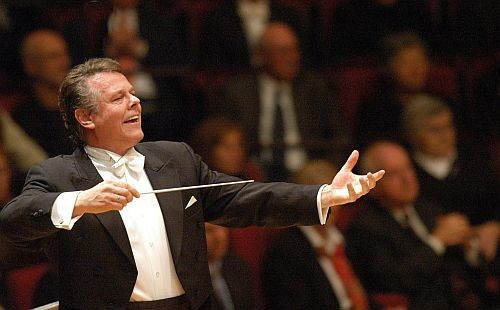 Germany Weber, R. Strauss, Shostakovich: Rudolf Buchbinder (piano), Symphonieorchester des Bayerischen Rundfunks / Mariss Jansons (conductor), Gasteig Philharmonic Hall, Munich, 25.10.2019. (JR)
Germany Weber, R. Strauss, Shostakovich: Rudolf Buchbinder (piano), Symphonieorchester des Bayerischen Rundfunks / Mariss Jansons (conductor), Gasteig Philharmonic Hall, Munich, 25.10.2019. (JR)

Weber – Overture, Euryanthe
Mozart – Piano Concerto No.23 in A K488
Shostakovich – Symphony No.10 in E minor Op.93
Weber’s opera Euryanthe has been rarely performed since its composition two hundred years ago (its libretto is considered weak); the opera has had its champions, musicologist Donald Tovey for one; and there is, I believe, just one commercial recording, which says it all. Toscanini performed it back in 1902, and Giulini in the 1950s; in recent years it appears to be trying to make a comeback. The opera’s overture, on the other hand, is a regular concert favourite.
As many readers will be aware, Mariss Jansons has recently not been in the best of health: as the orchestra’s own website put it before the summer holidays: ‘Mariss Jansons is undertaking a regenerative break on the advice of his doctors’. Jansons cancelled all his Munich concerts and a whole tour, including an appearance at the Proms. Prominent conductors were called on as replacements. Music-lovers may recall that Jansons suffered a massive heart attack in 1996 and nearly died. He is visibly still not a fit man and must conserve what energy he has. He shambled and shuffled onto the stage, nearly stumbling off it at the end. Concertmasters nowadays would do well to have first-aid skills. I doubt the orchestra had more than one rehearsal of the Weber overture, and it sounded appropriately. The notes were all there, they went through the motions, but there was no fizz or sparkle. Jansons was economical with his gestures. It should have been a fun curtain raiser but fell utterly flat.
The concert was redeemed by the Mozart which received a charming performance by veteran pianist Rudolf Buchbinder who is a regular on the Munich scene (some locals say, too regular). Only a few years younger than Jansons, he looked a picture of health. His light touch and graceful lyricism delighted the audience; more relaxed a pianist cannot look. The languorous slow movement was a wonder, the spirited, playful final movement a joy. Buchbinder is known for his interesting encores and he made no exception for this concert: some Bach with one hand covering the other, a pity only the left-hand side of the hall could see the keyboard.
When the Bavarian Radio Symphony Orchestra first published their season’s programme, this concert was supposed to feature Bruckner’s Ninth Symphony in the second half. It was changed, at some stage during the summer, to Shostakovich’s Tenth. I can only surmise that the Shostakovich, which Jansons knows like the back of his hand, was less effort for him. I must say I am not entirely convinced by Jansons as a Brucknerian; but with Shostakovich I am in no such doubt.
Shostakovich’s Tenth Symphony was written in the months following the death of Stalin and it is said that the Allegro movement is a musical portrait of the Russian dictator; the symphony should be a biting response to the condemnation the composer had suffered. This performance, however, had little bite or intensity – this was, sadly, not the Jansons we know of old. He was on autopilot, and I came away rather deflated. On a positive note, the orchestra were utterly magnificent across the board, particularly the secure horns and their woodwind principals. They also have an exceptional timpanist.
The orchestra plays some of its concerts at the Herkulessaal, others (such as the one I attended) at the Gasteig. Opened in 1985, the Gasteig has the air of the Seventies. I would compare it to the Barbican in London, which is from the same era. The Gasteig is a very large hall, seating 2,350, a wood-panelled seashell but, at least in its early years, it suffered from poor acoustics. When Bernstein was asked what he thought of the hall, he said ‘Burn it’. There have been attempts to improve the acoustics, the most visible of which are large glass (or plexi-glass) ‘mushrooms’ hanging over the stage. I have to say that, sitting in the stalls, I was not overly troubled by the acoustics, but nor was I greatly impressed. The local politicians have been arguing (and even I think litigating) about whether to build a new hall, and the decision was felled last year to build one (slightly smaller capacity than the Gasteig, strikingly almost controversially modern) a little further out of the centre near the Ostbahnhof, in the so-called light industrial Werksviertel. The hall has already been nicknamed ‘The Coffin’ referring to its shape and ‘The Greenhouse’ (there will be huge expanses of glass).
Mariss Jansons has pledged the rest of his working life to Munich and the BRSO and has a contract until 2024. He is clearly revered in Munich but there are loud voices (such as Robert Braunmüller in the the Münchner Abendzeitung at the end of June) saying that Jansons should go now, make way for younger blood, at a time when the Gasteig will soon be closed for some years due to extensive renovation. The closure of the Gasteig and move to the new hall cannot be co-ordinated time-wise. The orchestra will therefore have to move to a temporary hall, at the Brudermühlbrücke, way out of the centre of town, in around 2021; the Zurich experience of the ‘old’ Tonhalle (currently under renovation) and the Tonhalle Maag on Zurich’s northern fringes shows that audience numbers can then be adversely affected by such temporary arrangements. Only time will tell.
John Rhodes
